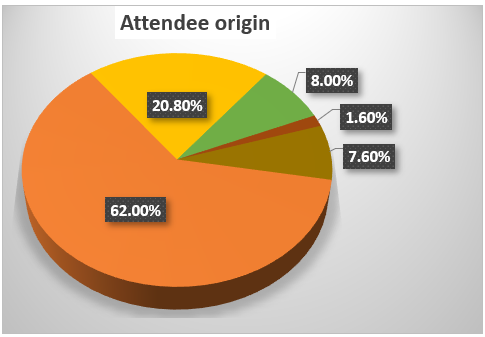On 6 June 2023, a conference was held on "The Public Sector Contracts Law: Does it favor value-based procurement?”, organised by the Subdirectorate General for Public Procurement of the Madrid Health Service (SERMAS), with the collaboration of Impulsa Salud (Mateos 2023a, 2023b, 2023c).
A few days after the conclusion of the conference, a summary of the conclusions and a survey were distributed to the attendees via email to gauge their perceptions of the event. We will now analyse and present the results of the surveys.
Key Points
- The response rate to the surveys is within the parameters considered good or very good.
- The results obtained reflect the high calibre of the speakers and the interest in the content of the conference.
- These results reflect the interest in value-based procurement as a strategic public procurement model.
Results of the Survey Responses from Attendees of the Value-Based Procurement Conference on Value-Based Procurement in Madrid
The Conference
The aim of the conference was to analyse the current scenario of value-based public procurement, its practice and its potential for the development of innovative purchasing strategies.
To this end, a small group of key players in public healthcare procurement were invited. Their objective was to share their opinions and experiences from their own knowledge, examining the current state of public procurement, its practice and its potential for developing innovative value-based procurement strategies within the healthcare sector. The objective was also to delve into socially responsible public procurement. Participants engaged in discussions, aiming to draw conclusions that would contribute to and influence the improvement of procurement based on transparency, trust and accountability.
The speakers were divided into two panels. The first-round table comprised of four speakers who presented specific advances in value-based purchasing from different areas: hospital, economic operator, public procurement service and health consultancy.
The second-round table, also featuring four speakers, comprised experts from the legal, auditing, fiscal-economic and university fields. These experts shared their perspectives in favour of the change of model in public procurement.
The round tables were preceded by a lecture by Elisa Frenz, CEO Health Proc Europe Association, who framed the content of the conference with clear references to the field of public procurement in Europe.
The participant profile for the conference was individuals associated with public procurement and healthcare management, possessing knowledge and experience that could contribute valuable reflections and innovative practices in value-based procurement, in order to enrich the debate. For this reason, the call was particularly open to professionals from the local administration, including personnel from the Madrid Health Service (SERMAS), both from central services and from hospitals and primary care centres. Economic operators were also encouraged to attend.
The expected participants or attendees had to register for the conference beforehand.
A total of 329 people registered for the conference, with the majority being economic operators from the field of pharmaceuticals, medical devices and healthcare technology (61.40%). Following closely were professionals from hospitals and healthcare centres with expertise in public procurement (20.97%), followed by professionals from public organisations (9.12%). This was followed by professionals from the central services of the Madrid Health Service (SERMAS) responsible for centralised public procurement (6.69%). Lastly followed were various professionals who were not linked to centralised public procurement (6.69%), and various professionals not linked to the previous groups, referred to as individuals to differentiate them from the other groups (1.82%).
On the day of the workshop, a total of 250 professionals attended (75.99%), with no major differences in the percentages by the groups indicated (Graph 1).

Graph 1
Once the conference was over, a summary of the conclusions and a survey were distributed among the attendees to discover how the conference had been perceived.
An easy and simple approach was proposed for the survey method, which consisted of marking each question with a closed answer. Participants were asked to assign a rating on a scale between 0 (none) and 5 points (maximum).
The questions were divided into 2 blocks:
A. Those linked to the organisation, in a total of 7 questions:
- How relevant was the theme of the conference?
- Did the conference meet your expectations?
- Would you recommend the workshop to people in your work environment?
- Did you find the duration of the workshop to be adequate?
- Did you find the organisation of the workshop to be adequate?
- Did you find the venue of the conference to be suitable?
- Do you believe that this type of conference should be continued in order to advance knowledge of value-based purchasing?
B. Those linked to the speakers, two questions were asked about each one of them:
- Knowledge of the subject.
- Clarity of exposition.
Results:
The survey was answered by 80 participants (32% of the attendees), which is considered a good or very good response rate according to the authors (Lindemann 2021; Ramshaw 2023; Muguira 2023). The breakdown of response rates for each group of participants is as follows:
- Economic operators: 30.97%.
- Professionals in hospitals and health centres: 28.85%.
- Professionals from public organisations: 25%.
- Professionals from SERMAS: 57.89%.
- Private individuals: 25%.
As observed, the response rates to the survey for each group of participants are very similar across all categories, with the exception of the group of SERMAS professionals. This group represented more than 50% of the total number of participants, which can be explained by the fact that this was the internal group of participants.
Upon studying the 80 responses obtained, it is apparent that 60% of them belonged to economic operators, 18.75% of the surveys came from hospital and health centre professionals, 13.75% from the central services of SERMAS, 6.25% from other organisations, and the remaining 1.25% were responses from the group known as individuals (Graph 2).

Graph 2
With regard to the questions in the first block, the results revealed an overall score of 4.73. The results for each question are as follows:
- Relevance of the theme of the conference: 4.84.
- The conference met expectations: 4.58.
- Recommend the workshop to people in your work environment: 4.64.
- The duration of the workshop was adequate: 4.46.
- The organisation of the workshop was adequate: 4.89.
- The venue of the conference was suitable: 4.81.
- This type of conference should be continued in order to advance knowledge of value-based purchasing: 4.89.
With regard to the questions in the second block, the results show an overall score of 4.43. The results for each question are as follows:
- Knowledge of the subject: 4.52.
- Clarity of the exposition: 4.34.
The distribution based on the participants' origins is detailed in Table 1, showcasing the results for the first block of questions. The table highlights that there are no significant differences observed among the various respondent groups. However, the group of economic operators stands out as the group with the highest score, followed by the SERMAS group (Table 1).
ORIGIN | Nº SURVEYS | SCORE |
COMPANY | 48 | 4,79 |
HOSPITAL | 15 | 4,54 |
ORGANIZATION | 5 | 4,63 |
INDIVIDUAL | 1 | 4,29 |
SERMAS | 11 | 4,82 |
TOTAL | 80 | 4,73 |
Table 1
Upon analysing the second block of the survey, which refers to the speakers, the knowledge section emerges as the most highly valued quality, particularly concerning the clarity of the presentation. This may be due to the complexity of the messages linked to the applicable public procurement law and the expert profile of the speakers themselves. Table 2 illustrates the scores by respondent groups and the overall score for the quality "knowledge", which reached a score of 4.52. In comparison, the quality of "exposition” scored 4.34 (Table 2).
ORIGIN | Nº SURVEYS | KNOWLEDGE | EXPOSITION |
COMPANY | 48 | 4,55 | 4,34 |
HOSPITAL | 15 | 4,31 | 4,15 |
ORGANIZATION | 5 | 4,42 | 4,31 |
INDIVIDUAL | 1 | 3,78 | 4,22 |
SERMAS | 11 | 4,80 | 4,67 |
TOTAL | 80 | 4,52 | 4,34 |
Table 2
When examining these data by the group or origin, the SERMAS group stands out by providing the highest scores for both qualities. It is crucial to note that this group is made up of public procurement professionals from central services, characterised by their vast knowledge and consistent experience.
If we analyse the overall results by speaker and table, considering the attendee groups, the first table achieved an overall score of 4.34, while the second table scored 4.58, resulting in an overall score of 4.43 for all presentations.
Analysing these overall results according to the groups of attendees, the outcome is as follows (Table 3):
ORIGIN | AVERAGE SCORE OF THE ORGANIZATION | AVERAGE SCORES BY ASPECTS OF THE SPEAKERS | AVERAGE SCORE OF THE SPEAKERS | AVERAGE SCORE OF THE CONFERENCE | |
Knowledge | Exposition | ||||
COMPANY (48) | 4,79 | 4,55 | 4,34 | 4,44 | 4,54 |
HOSPITAL (15) | 4,54 | 4,31 | 4,15 | 4,23 | 4,32 |
ORGANIZATION (5) | 4,63 | 4,42 | 4,31 | 4,37 | 4,44 |
INDIVIDUAL (1) | 4,29 | 3,78 | 4,22 | 4,00 | 4,08 |
SERMAS (11) | 4,82 | 4,80 | 4,67 | 4,73 | 4,76 |
TOTAL (80) | 4,73 | 4,52 | 4,34 | 4,43 | 4,52 |
Table 3
Conclusions:
- The profiles of the attendees were broader than initial expectations based on the participant call.
- A survey response rate of 32% was obtained.
- The results of the first block of questions showed an average of 4.73.
- The results of the second block of questions showed an average of 4.43.
- The overall results of the conference provided an average score of 4.52.
These results encourage us to move forward in value-based procurement, given the number of people interested and the significant interest generated among the different profiles of attendees (public administrations, public managers, suppliers of products and services, and health professionals).
SPECIAL MENTION: I would like to thank Leonor Tirado Gutiérrez for her support in writing this blog and for creating the graphs and tables shown.
References:
- Adrián Mateos (2023a) Cronicidad y envejecimiento fuerzan al SNS a "innovar en la compra pública. redacción médica. Available at: https://www.redaccionmedica.com/secciones/derecho/cronicidad-y-envejecimiento-fuerzan-al-sns-a-innovar-en-la-compra-publica--7788
- Adrián Mateos (2023b) El valor en salud, "palanca de cambio" a otro paradigma en compras públicas. redacción médica. Available at: https://www.redaccionmedica.com/secciones/derecho/el-valor-en-salud-palanca-de-cambio-a-otro-paradigma-en-compras-publicas-6948
- Adrián Mateos (2023c) La sanidad española debe superar la cultura de que menos precio es mejor. redacción médica. Available at: https://www.redaccionmedica.com/secciones/derecho/-la-sanidad-espanola-debe-superar-la-cultura-de-que-menos-precio-es-mejor--2175
- Lindemann N (2021) What’s the average survey response rate? [2021 benchmark]. Pointerpro. Available at: https://pointerpro.com/blog/average-survey-response-rate/
- Ramshaw A (2023) The Complete Guide to Acceptable Survey Response Rates. Genroe. Available at: https://www.genroe.com/blog/acceptable-survey-response-rate-2/11504
- Muguira A (2023) Haz crecer la tasa de respuesta de tus encuestas. QuestionPro. Available at: https://www.questionpro.com/blog/es/mide-la-tasa-de-respuesta-de-tus-encuestas/























